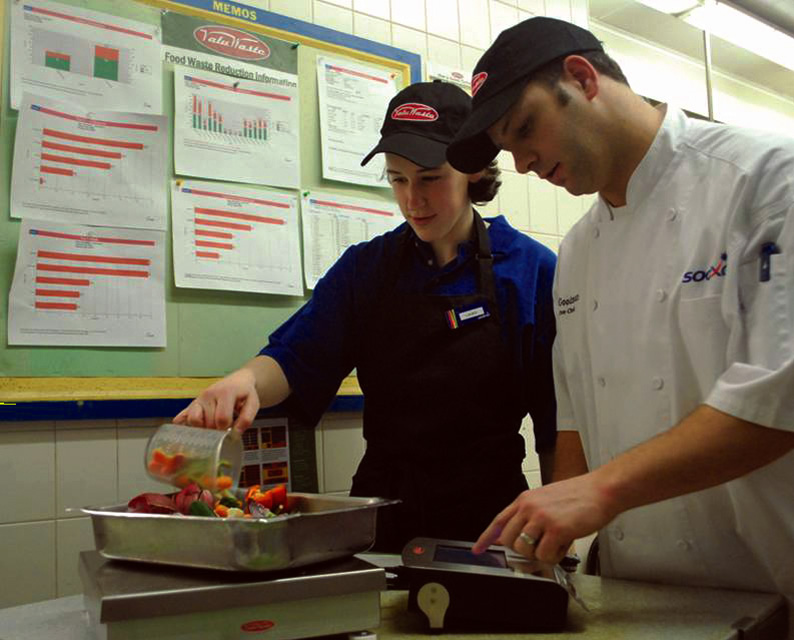As a growing number of clients seek to become more environmentally friendly, purveyors of dining services compete to meet their needs.
Dan Sullivan
BioCycle April 2012, Vol. 53, No. 4, p. 32
When institutions and large companies put their dining service needs out for bid, they may request that proposals spell out upfront how programs will help clients reduce their carbon footprint and improve their overall environmental stature in the community. That is not a bad strategy, says John Turenne, president and founder of Sustainable Food Systems and former director and executive chef at Yale Sustainable Dining. “The RFP process is really the time to lay out expectations, criteria and standards when it comes to sustainability,” explains Turenne, who facilitates and manages local and sustainable dining programs for institutions and businesses. “Then it is articulated right from the get go between the client and the contracted company.”
A 25-year veteran of Aramark, an institutional food service provider with 250,000 employees and operating in 22 countries, Turenne became exposed to sustainability in the food service industry while executive chef at Yale University. In 2000, a group of students in an environmental health and policy class began pushing for more organic choices in the dining hall. But it wasn’t until the daughter of Alice Waters of Chez Panisse — an early adopter of serving locally grown food — enrolled at Yale that the university higher ups paid attention. Waters spoke with Yale President Richard Levin about instituting a sustainable dining program. “Alice convinced the president that he should do this,” recalls Turenne. “He became intrigued, put the vice president of finance in charge and he said ‘do this.’ … As the proverbial stuff rolled downhill, it finally came to me and I said, ‘Okay, what the heck is sustainable food?’ That’s when Alice really took me under her wing and taught me the whys and hows and I began to change my view of things.”
Now a speaker and facilitator to diverse audiences including sustainable agriculture organizations and food policy groups, as well as a consultant to food service organizations ranging widely in size, scope and geography, Turenne sees four pillars of sustainability relative to institutional dining: Minimizing environmental impact; Sustaining local economies; Addressing social implications of food production, such as workers rights and animal welfare; and Supporting the health and well being of individuals and communities. “That’s how I determine sustainability when it comes to food,” he says.
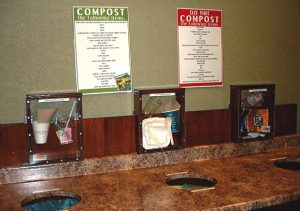
Chatham University in Pittsburgh is one of 14 Eat’n Park Hospitality Group accounts composting postconsumer food waste at the front of the house.
Measuring Up
BioCycle spoke with five different food service contractors to trace the trajectory of their sustainability platforms. Eat’n Park Hospitality Group serves more than 100 institutional and corporate clients in the Pennsylvania region and operates a chain of 72 fast food restaurants in the western part of the state. Unidine offers boutique local, fresh-food catering services to about 150 assisted living facilities, hospitals and businesses in the Boston region. Palo Alto, California-based Bon Appétit (a subsidiary of the much-larger Compass Group) manages more than 400 cafeterias for corporations, colleges and universities across the United States. And Sodexo and Aramark, like Bon Appétit’s parent company, each employ hundreds of thousands of food service professionals serving institutional and corporate clients across the globe. Each of the five companies articulated sustainability platforms that also are outlined on their respective websites. Several categories of these programs are highlighted.
Organics Recycling And Serviceware
“About 17 locations that we serve are diverting food waste, primarily colleges and six companies including PNC bank,” says Jamie Moore, Director of Sourcing & Sustainability for Eat’n Park Hospitality Group, which also encompasses Parkhurst Dining Services and Cura Hospitality. “Out of those 17 locations, 14 use compostable serviceware.” The remaining accounts have begun preconsumer food waste recycling at the back of the house but not yet postconsumer at the front of the house, Moore notes, adding that his company encourages use of recyclable products in regions where commercial composting is not an option and reusable serviceware, such as china and metal utensils, wherever that option is practical. “I don’t think compostable serviceware should be the stopping point,” he says. Packaging of individual table settings is also discouraged.
At Unidine, “composting is really client by client, especially on the business dining side,” says Senior Director of Sales & Marketing Rob Teplansky, adding that his company partners with Massachusetts-based recycling company Save That Stuff to offer composting and recycling programs to clients who want that option. “Many of our senior communities and hospitals have gardens on-site” where they can both make and utilize the compost, he says. “Gardening is also part of the healing process at a lot of those locations.” And wherever possible, he adds, “we really try to purchase china, silverware and glassware … so we’re washing and reusing.”
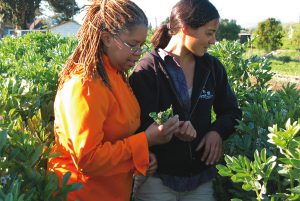
Marsha Habib (right) of OYA Organics shows Tiana Driggins, Bon Appétit executive chef at Santa Clara University, some tender pea shoots, a typical farmer-chef connection fostered by the company’s farm to fork program.
At Sodexo, says Christy Cook, Senior Manager in charge of Sustainability Deployment and Field Support, the company follows the US EPA’s Food Waste Recovery Hierarchy, first tackling source reduction through more-careful purchasing and tracking; food donation; direct feeding to animals; diverting waste to industrial uses such as anaerobic digestion or processed into animal feed; composting; and, as a last alternative, landfilling or incinerating. Sodexo also uses the hierarchy to educate clients, Cook adds, offering the example of Marist College, which since implementing food waste composting in 2008 has recycled more than one million pounds of organics. “The students, faculty and administration approached us saying ‘Let’s compost and increase recycling,’” she recalls. “We said, we can do that, but let’s also talk about source reduction.” Sodexo connected Marist with LeanPath — a Portland, Oregon-based company that provides food waste tracking systems to the hospitality, food service and restaurant industries. The college has participated in a pilot program run by LeanPath since 2010 and has reduced preconsumer food waste by 47 percent, says Cook. Based on that success, Sodexo is partnering with LeanPath to launch a broad food waste reduction program in the campus services market.
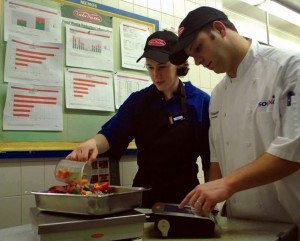
Sodexo partnered with Portland, Oregon-based LeanPath to first quantify then try to eliminate Food Waste.
Aramark also focuses first on source reduction following EPA’s Food Waste Recovery Hierarchy. “Before food even reaches a consumer, we focus on reducing the amount of food waste being generated during the production processes, through standard operating activities at every stage from planning to post analysis,” says Kathleen Cacciola, Senior Director for Environmental Sustainability and Corporate Responsibility. One strategy for minimizing food waste on the consumer end, particularly in colleges and universities, is trayless dining. “As documented in our July 2008 white paper, trayless dining has been shown to reduce food waste by 1.5 ounces per person per meal, representing a 25 to 30 percent reduction in food waste per person per meal,” notes Cacciola.
The medium for recycling organics depends upon service availability as well as client preference. She says Aramark has instituted successful composting programs throughout numerous client locations including college campuses, convention centers and tourist destinations. “For example, at the Anaheim Convention Center, within one year of launching the program, they’re already composted approximately 500 pounds/day of food waste.” Aramark has also partnered with Clean Air-Cool Planet to develop the CHEFS (Charting Emissions through Food Services) tool to help college campuses understand the impacts of their choices.
Food Donation
Despite rigorous protocols to counter waste before it happens, surplus inevitably occurs due to unforeseen circumstances such as cancelled events. “To facilitate a company-wide solution, Aramark has established a pilot program with the Food Donation Connection (FDC), an industry leader in coordinating prepared surplus food donations.” Partnering with FDC allows Aramark the benefit of an organization with vast experience in donating prepared food. “Managing a safe, effective, and efficient food donation program requires participation of many people throughout Aramark, along with development of standard operating procedures that enable us to clarify and specify whether products are safe to donate,” Cacciola says.
At Sodexo, “hunger is one of the core issues,” says Cook, adding that the nonprofit Sodexo Foundation (funded by the company) was specifically created to tackle this issue. Initiatives include the Backpack Food Program where the foundation partners with local food banks and schools to provide knapsacks filled with nutritious, easy-to-prepare, nonperishable food for students who are at risk for hunger when free or-reduced price school lunches are unavailable. Another program, the Campus Kitchen Project, recruits volunteer college students to recycle food from their dining halls, prepare meals and distribute them to various hunger relief agencies. And Sodexo is one of the world’s largest donators of perishable and nonperishable food items to the nonprofit Feeding America.
Supporting Local/Sustainable Agriculture
“This year we hit $23 million buying locally within our company,” says Eat’n Park’s Moore. “That represents 20 percent of our annual food purchasing dollars.” The company’s definition of “local” is produce sourced within a 125-mile radius. Meats and bakery goods are regionally sourced through local and artisan producers. “It might be a local bread baker or artisan sausage maker right down the street from you,” he explains. The third category, dairy, will be “a local brand recognized within the community” and will always be free of hormones.
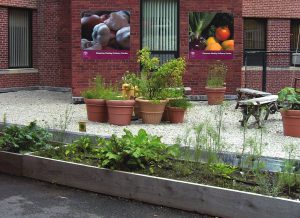
Unidine’s healthy fresh food initiatives include local, organic produce available for purchase in the New Milford Hospital cafeteria and a healing garden (above) on the hospital’s loading dock.
In 1999, Bon Appétit launched the Farm to Fork program, a companywide initiative requiring its chefs to buy at least 20 percent of their ingredients locally. “The company now spends tens of millions of dollars per year with the thousand-plus small, local farmers and artisans in our network,” says York, noting that the modest family farms the company supports have lesser impact on the land because they tend to eschew chemical inputs in favor of compost, cover crops and diversity. “Sustainability” has social implications, too, she adds. “We have been involved in policy advocacy in the field including recognizing that farm workers need decent wages for our agricultural system to be truly sustainable. Our CEO served on the Pew Commission on Industrial Farm Animal Production and has testified before Congress twice, advocating for elimination of routine use of subtherapeutic antibiotics in the meat industry, as their overuse has unsustainable implications for communities and public health.”
In 2007, Bon Appétit implemented the Low Carbon Diet Program to encourage its chefs and guests to think about how their food choices could help reduce climate change and CO2 emissions in high impact areas by 25 percent over three years. “We know meat and dairy are especially high in carbon because ruminants — cows, sheep and goats —naturally emit methane,” says York. “To address this issue, we’ve successfully reduced beef purchases by 33 percent and reduced our cheese purchases by 10 percent.”
Aramark, in partnership with wholesale distributors Sysco and FreshPoint, has also increased the availability of locally sourced produce, says Cacciola. “Together, we communicate weekly to our buyers about the availability of local produce. While the definition of local may vary from client to client, in this case we use 250 miles as the measure. The varying criteria for locally sourced — by miles, state, etc. — as defined by clients, and limitations due to season availability are some of our biggest challenges in providing locally sourced foods.”
Permanence of Sustainability Programs
According to Aramark, the company’s focus on environmental sustainability is part of its broader corporate responsibility commitment to having a diverse workforce, protecting the environment, strengthening communities and advancing consumer health and wellness. “As a company that not only operates its own facilities, but also manages a variety of services at thousands of client locations, we have a dual responsibility to integrate environmental sustainability practices at company-owned sites and to support client sustainability initiatives around the world,” says Cacciola. Aramark’s overall strategy toward that end, she says, is to improve existing platforms, products and services to create scalable, sustainable and practical programs that reap tangible and lasting environmental benefits. “Our focus is on practices that we can replicate across thousands of locations, not just ‘one-off’ events, but programs that can be implemented on a much larger scale and significantly impact our environmental footprint,” Cacciola says. “To ensure a holistic approach to environmental sustainability, we focus on the procurement of products on the front end, environmentally friendly operations, and waste management strategies on the back end.”
Sodexo’s sustainability initiatives are “simply building on what our company has fundamentally been about since it was founded in 1966, to ‘make everyday a better day,’” says Henry. “It’s why we do what we do. So while Sodexo formally created a sustainability plan in 2009, it feels like it’s just a clarification of how the company works.”
By the time Unidine started in 2001, sustainable practices were a “hot button issue,” says Teplansky. “So from the very beginning, we had to consider sustainability in our operations. Also from the very beginning, our focus first and foremost was based on a philosophy of fresh food ingredients made from scratch to order. When you start with this type of a philosophy, there’s a certain amount of sustainability built right into your operations.” For instance, he says, by cooking from scratch and sourcing locally, the company largely circumvents the processing, packaging and distribution components of an industrial food system and their related carbon footprint. “We look for clients who are a match for us as far as our culture and philosophy, and we don’t step out of that box,” he adds. “Since we utilize incredible efficiencies — essentially using everything — most times we are able to improve a client’s quality of service and remain cost neutral. But if they are looking only for lower cost, we’re probably not the right partner.”
Eat’n Park’s Moore, who sits on the board of the Pennsylvania Association for Sustainable Agriculture, attributes his company’s sustainability initiatives to a desire to be an exemplary environmentally responsible member of the community — both because it’s the right thing to do and because it sends a powerful marketing message — as well as because it’s what clients want. “We’re simply following through with their requests,” he says.
Sustainable Food Systems John Turenne suggests that while sustainability goals and benchmarks are admirable, they can quickly become platitudes if the main ingredient is not present: establishing enduring relationships. “I started to realize that food has a story, and that I had never stopped to think about or consider or be aware of that,” he explains. “I had always thought of food as a business, simple profit and loss — as executive chef at Yale we were talking considerable volume, probably $9 million annually. We were buying food in the global marketplace and I never thought about the impact of my own decisions on the planet we live on, or upon communities and the small farms in my own state until I started to see the faces behind the food. The pride factor and the taste buds kicked in.
Food was no longer just a seven-digit order number arriving anonymously with hundreds of other products off the back of a truck, but organic greens grown year-round by David and Ty Zemelski of Starlight Gardens in Durham, Connecticut.”


